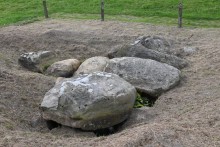|
|
|
|
Archsum 1Passage Grave
|
||||||||||||||||||
|
|
|
Images (click to view fullsize) |
|
Photographs:





 Maps / Plans / Diagrams:
Maps / Plans / Diagrams:


|
Fieldnotes |
|
|
The Merelmerskhoog is one of the best preserved megalithic tombs on Sylt. The passage grave is located southwest of Archsum directly at the foot of the Nössedeich (Deich means dike). The two giant beds Archsum 2 and Archsum 3 are in a direct line on the other side of the dike in the Wadden Sea. The locals call this place in Sylt Frisian "Mootjis Küül" (Grandmother's Hollow). The burial chamber is oriented in a north-south direction and consists of four support stones on the long sides and two stones on the narrow sides. There are four capstones on top of the chamber, the middle ones are slightly displaced. The size of the chamber is 5.3 × 1.5 m. The 3.5 m long corridor begins in the middle of the eastern long side and consists of three pairs of stones with corresponding cap stones. Probably because the tomb is at sea level (possibly even a little lower), there is water in the burial chamber. To get to the tomb, turn shortly before leaving the village in the direction of Keitum from the Dorfstrasse in Archsum south into Uaster Reeg. Then turn right into Weesterstich and after 250 m turn left into Deichweg. Follow this road south-west for 1.6 km, there is a parking lot immediately in front of the Nössedeich (dike). Walk left from here in a northwesterly direction for about 800 m on the paved road (don't cross the dike) to reach the site. Visited September 2020 |
1st November 2020ce Edited 14th November 2020ce |
|
taken from the on-site hünen.kulTOUR information boards: Merelmershoog The Merelmershoog lies on the edge of a small Geest ridge, the Mittelmarsch (Merelmers). The Neolithic megalithic tomb is an oval passage grave of the Nordic type. It is one of only three surviving passage graves on Sylt, including the famous Denghoog in Wenningstedt. The burial chamber probably consisted of 12 supporting stones (one of which is missing) and four cap stones and was about 1 m high. When the Nössedeich was built in 1938, the tomb was in danger, but the relocation of the dike made it possible to preserve it. Other destroyed megalithic tombs, which today lie far in front of the dike in the mudflats, testify to the former expansion of the Geest. About 1,000 m southeast of the tidal flats are the remains of another passage grave, the Kolkingehoog. It was destroyed by storm surges and ice drift in the 19th century. Megalithic tombs In the Middle Neolithic, the Funnel Beaker Culture built imposing large stone or megalithic tombs within a short period of around 600 years. These tombs, which are still imposing today, partly consist of massive boulders. Almost 50 megalithic tombs are known of Sylt, eight of which have been wholly or partially preserved. The most imposing of them and one of the most beautiful and best-preserved megalithic tombs in Germany is the Denhoog in Wenningstedt. Megalithic tombs are collective graves that have been used repeatedly and over a very long period of time. Only the bodies of the dead were buried. The tombs were often reused in the following epoch (Bronze Age). The shape of the tombs developed from simple rectangular stone chambers to dolmens, polygonal chambers and passage graves. The corridor made subsequent burials easier. The tombs were covered with earth and had the outer shape of round or long barrows. It is disputed whether the dead were buried directly in the graves or whether only the bones were later deposited. |
1st November 2020ce |

